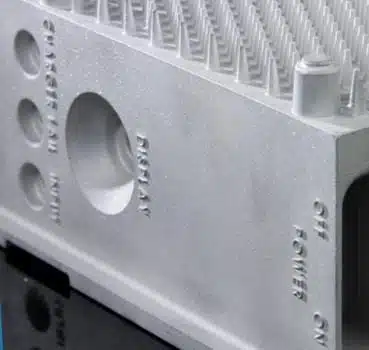
One of the primary benefits provided by the Investment Casting process is that part detail can very often be furnished at negligible additional cost. Engineers frequently take advantage of this “free” capability by incorporating cast lettering and marking into their part designs. Marking can be almost anything from letters, numbers, logos, trademarks or be simply decorative.
There are basically two types of cast marking, “Integral” or “Applied”. Integral-marking is embedded into a pattern mold so that the identical marking appears on each part cast. Applied-marking such as that made by laser, vibro-etch or ink stamping is applied to the finished product and used most often to identify castings with information that changes part-to-part or lot-to-lot such as serial numbers or heat treat lot data. We will devote our attention here to integral-marking.
Integral-marking, being permanently cut into the pattern mold, is somewhat difficult to alter. Although there are methods by which to integrally cast variable information this does add an element of cost to the casting and so is better suited for one of the applied-marking methods.
Integral-marking can be either raised or depressed on the casting surface but given a choice foundries tend to prefer that marking be raised. The reason for this preference is that positive features on a part are the inverse in the pattern mold. Thus a depressed part marking will be raised on the surface of the mold so will be very susceptible to damage from handling of the mold. A designer desiring a depressed integral-marking (thus raised in the pattern mold) should consider designing the depressed lettering to be on a “raised pad” with the pad height being taller than the marking is deep. In this manner, in the pattern mold, the “pad” will be deeper in the mold than the lettering is high so the lettering be somewhat more protected from damage when the mold is being handled.
Though commonplace, whether integral-marking be raised or depressed, there are other challenges that can be mitigated with good design. With investment casting it is important that integral-marking be sufficiently substantial in height and stroke-width that the process will robustly reproduce them. If marking is too shallow it will not be legible on the cast part or if too deep the integral-marking may suffer from metal penetration so, for example, the loops of a letter “B” fill with metal to then more resemble a letter “D”.
O’Fallon Casting suggests that the raised height or depth of the integral-marking be .010 – .015” from the casting surface depending on the choice of characters or fonts. Characters and forts will cast optimally without any sharp edges or corners.
Incorporating Integral-marking into designs is one way to take advantage of the investment casting’s ability to provide part detail at minimal expense. If you have any question if an integral-marking should be included in your casting design, please consult your O’Fallon Casting Sales Engineer.
